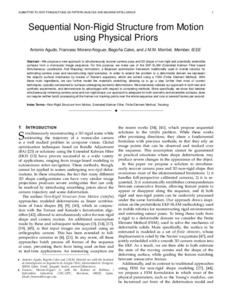Mostra el registre d'ítem simple
Sequential non-rigid structure from motion using physical priors
| dc.contributor.author | Agudo Martínez, Antonio |
| dc.contributor.author | Moreno-Noguer, Francesc |
| dc.contributor.author | Calvo, Begoña |
| dc.contributor.author | Martinez Montiel, José Maria |
| dc.contributor.other | Institut de Robòtica i Informàtica Industrial |
| dc.date.accessioned | 2017-03-20T08:42:14Z |
| dc.date.available | 2017-03-20T08:42:14Z |
| dc.date.issued | 2016-05-01 |
| dc.identifier.citation | Agudo, A., Moreno-Noguer, F., Calvo, B., Montiel, J. Sequential non-rigid structure from motion using physical priors. "IEEE transactions on pattern analysis and machine intelligence", 1 Maig 2016, vol. 38, núm. 5, p. 979-994. |
| dc.identifier.issn | 0162-8828 |
| dc.identifier.uri | http://hdl.handle.net/2117/102636 |
| dc.description | © 20xx IEEE. Personal use of this material is permitted. Permission from IEEE must be obtained for all other uses, in any current or future media, including reprinting/republishing this material for advertising or promotional purposes, creating new collective works, for resale or redistribution to servers or lists, or reuse of any copyrighted component of this work in other works. |
| dc.description.abstract | We propose a new approach to simultaneously recover camera pose and 3D shape of non-rigid and potentially extensible surfaces from a monocular image sequence. For this purpose, we make use of the Extended Kalman Filter based Simultaneous Localization And Mapping (EKF-SLAM) formulation, a Bayesian optimization framework traditionally used in mobile robotics for estimating camera pose and reconstructing rigid scenarios. In order to extend the problem to a deformable domain we represent the object's surface mechanics by means of Navier's equations, which are solved using a Finite Element Method (FEM). With these main ingredients, we can further model the material's stretching, allowing us to go a step further than most of current techniques, typically constrained to surfaces undergoing isometric deformations. We extensively validate our approach in both real and synthetic experiments, and demonstrate its advantages with respect to competing methods. More specifically, we show that besides simultaneously retrieving camera pose and non-rigid shape, our approach is adequate for both isometric and extensible surfaces, does not require neither batch processing all the frames nor tracking points over the whole sequence and runs at several frames per second. |
| dc.format.extent | 16 p. |
| dc.language.iso | eng |
| dc.rights.uri | http://creativecommons.org/licenses/by-nc-nd/3.0/es/ |
| dc.subject | Àrees temàtiques de la UPC::Informàtica::Automàtica i control |
| dc.subject.other | Non-Rigid Structure from Motion |
| dc.subject.other | Extended Kalman Filter |
| dc.subject.other | Finite Element Method |
| dc.subject.other | tracking |
| dc.subject.other | medical images |
| dc.subject.other | closed-form |
| dc.subject.other | shape |
| dc.subject.other | models |
| dc.subject.other | factorization |
| dc.subject.other | recovery |
| dc.subject.other | streams |
| dc.subject.other | slam |
| dc.title | Sequential non-rigid structure from motion using physical priors |
| dc.type | Article |
| dc.contributor.group | Universitat Politècnica de Catalunya. ROBiri - Grup de Robòtica de l'IRI |
| dc.identifier.doi | 10.1109/TPAMI.2015.2469293 |
| dc.description.peerreviewed | Peer Reviewed |
| dc.subject.inspec | Classificació INSPEC::Optimisation |
| dc.relation.publisherversion | http://ieeexplore.ieee.org/document/7208859/ |
| dc.rights.access | Open Access |
| local.identifier.drac | 18545479 |
| dc.description.version | Postprint (author's final draft) |
| local.citation.author | Agudo, A.; Moreno-Noguer, F.; Calvo, B.; Montiel, J.M.M. |
| local.citation.publicationName | IEEE transactions on pattern analysis and machine intelligence |
| local.citation.volume | 38 |
| local.citation.number | 5 |
| local.citation.startingPage | 979 |
| local.citation.endingPage | 994 |
Fitxers d'aquest items
Aquest ítem apareix a les col·leccions següents
-
Articles de revista [163]
-
Articles de revista [376]


